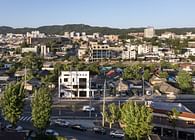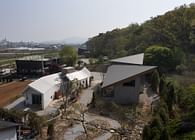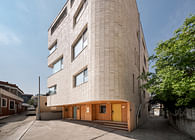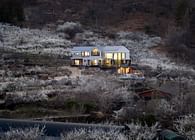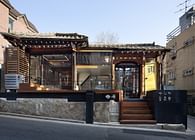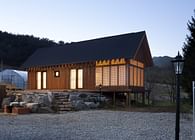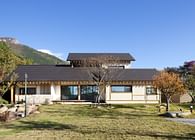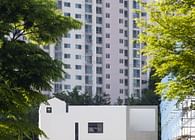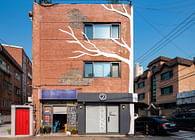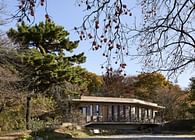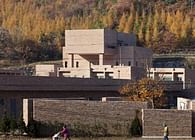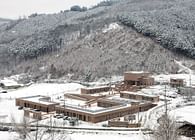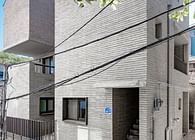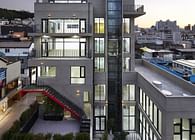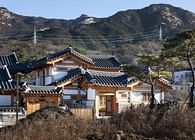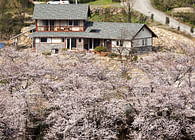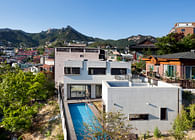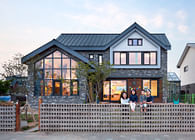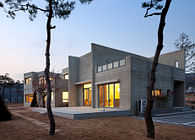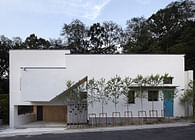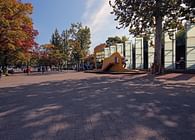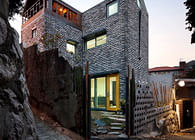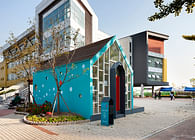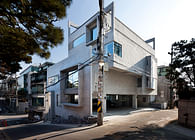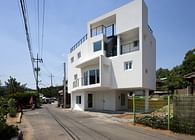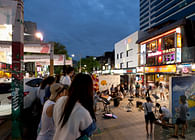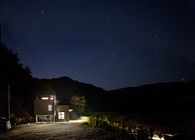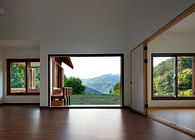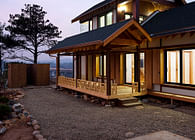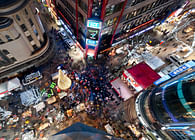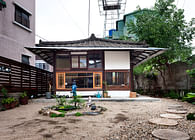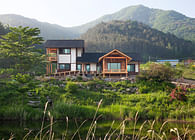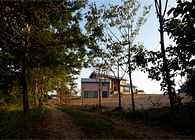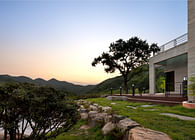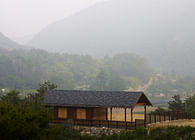
Seoul, KR
Choco Luce in Gonju
In Gongju city, Lucia’s husband Johan built a chocolatery and named it <Choco Luce> next to <Lucia’s Earth>, a space provided to study and consume tea.
The building is roofed with blue tiles and is situated adjacent from the fence and the garden of <Lucia’s Earth>. As a layer of cement was, with care, peeled off of pillars from an old Hanok (Korean traditional house) that was revived into the chocolatery, the <Choco Luce> yields rather a modern atmosphere comparatively to that of <Lucia’s Earth>’s traditional sentiment. Re-visitation, I believe, indeed is a glimpse of an aspect of constructing property and a part of building history.
Few years ago Johan’s wife Lucia revitalized an old house and its garden that had sat for many years empty of residents and its attendance and turned into the new <Lucia’s Earth>. The vacant alleyway thereby was inhabited with visitors. As flimsy foliage emerged and flowers bloomed from the garden, the nearby block then grew into what is to be called, ‘the alleyway where dragonflies came around to play’
Gonju was the capital city of Korea’s ancient kingdom, Beakje, then was later the municipal city of South Chungcheong Province. However, the population had been gradually decreasing as the residents left the city. It is unforeseen how <Lucia’s Earth> contributed in which to bring the pulse back into the reminiscence of the ancient citizenry.
Once a law professor at a university, Johan had an indefinite aspiration to at one point to make chocolate. He then became inspired by Lucia reviving the desolate alleyway and its garden and decides to become a chocolatier. As he decided to leave behind his profession to pursue his dream, like a fate - as if someone had been convoying his determination, the next-door house from <Lucia’s Earth> came onto the market.
This house, too, like <Lucia’s Earth>, was a Hanok that was built in 1960. It was, however, unlike the <Lucia’s Earth>, in which the owner attempted to maintain the originality of the form and lengthen its life span. This was lived-in space that was patched up with its age and its anatomy was transformed though time. Wooden pillars and earth walls were covered with cement and its roof was done with dull blue metal tiles.
There was a lack of unanimity about the house. Tall buildings enclosing its yard, the ┐- shaped (L-shaped) foundation, and the haphazardly put together Jangokdae (Korean ethnic earthenware used to ferment or to store comestible goods) sat awkwardly together. The sense of amenity present in a mature house was abruptly overthrown by a set of coarse attempts to re-fashion the house, which paradoxically left the space empty of spirit.
The first encounter with the house was in the late autumn and soon passed the winter while contemplating on where to begin; then came around the next spring when I found some moss cultivating between the cracks of the broken cement covered wall. This displayed, however, paradoxically, a hope for the change.
In spring, Johan began attending a chocolate making workshop in Seoul once a week. Chocolate is not only a simple staple but a form of artistry. Its particular shape and taste can be a projection of one’s dream. It takes a form of an angel, a jester, a castle and a tree. In a process of creation, the head and the hands work in synchrony to build the anatomy of a world.
While Johan learned to make chocolate, we began dreaming of a house.
We contemplated on what sort of narrative should unfold in <Johan’s Earth>, connecting to the secluded back fence of <Lucia’s Earth>. Eventually, it was apparent to us to bring in the affection of Johan’s dream into the old house where the conscience of the past was only faintly hanging.
The rather antagonistic finishing of the original outer wall and the beams found from the inside of the wall shall remain; rather, they would be reinforced with a little interpretation. This was my rule to refurbish the wall with a built-in frame to mimic the dark-skinned chocolate with sweet and soft inside.
The wooden floor and the walls were washed, padded up, and then repainted. Then red bricks were laid down in the garden, evenly distributed to allow foliage to grow out from the in-between spaces.
If one might say <Lucia’s Garden> is like grandmother’s place to visit to relax - perhaps even without the shoes on, Johan’s <Choco Luce> became a platform like mother’s table to sit around together with, turning slowly a ball of bitter-sweet chocolate melting on the tip of the tongue, while feeling the warmth of sun and slowly drenching into a daydream.
Status: Built
Location: Gongju, KR
Firm Role: Design, Supervision
Additional Credits: Architect: Hyoungnam Lim, Eunjoo Roh in studio_GAON
Project Team: Seongwon Son, Hanmoe Lee, Minjung Choi, Sangwoo Yi, Sungpil Lee, Joowon Moon
Translation: Hyoseon Hur
